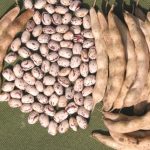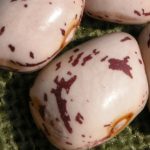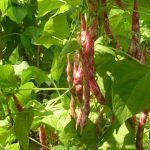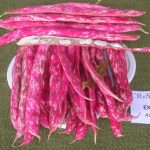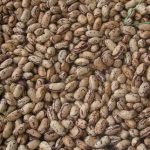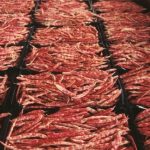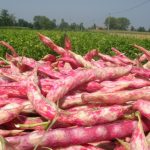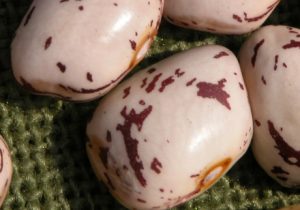
Name
Cuneo Bean
Seal of quality

Prodotto Agroalimentare Tradizionale (PAT) – Typical Food Farming Product. IGP (Protected Geographical Indication) status requested.
Description
The bean varieties cultivated in this area are the climbing varieties belonging to the Phaseolus vulgaris and Phaseolus coccineus species and among these there are varieties suitable for the production of dry grain, normally known as “dried bean” and others for the production of pods with waxy grains, known in the area as “red bean”. The most suitable varieties for the production of the “dried bean”, are the “Billò”, with their grain characterised by purplish-brown streaks on a cream background, and the ‘Bianco di Bagnasco’ and ‘Bianco di Spagna’ varieties, with completely white beans. The most important varieties for harvest at the waxy state are the ‘Stregonta’ (Tongue of fire) and the ‘Borlotto’.
Nutritional characteristics
The bean is particularly indicated to prevent anaemia for its high iron content, and in cases of energy loss thanks to its high calorie content. Diabetic and obese people can eat this instead of pasta and bread.
| FOOD | unit of measurement | Borlotti beans freschi crudi | Borlotti beans secchi crudi |
|---|---|---|---|
| Edible part | % | 52 | 100 |
| Water | g | 60,8 | 10,3 |
| Protein | g | 10,2 | 20,2 |
| Fat | g | 0,8 | 2 |
| Carbohydrates | g | 22,7 | 47,7 |
| Starch | g | 19,5 | 40,2 |
| Soluble sugar | g | 1,2 | 3,5 |
| Total fibre | g | 4,8 | 17,3 |
| Energy | kcal | 133 | 278 |
| Kilojoules | kJ | 557 | 1162 |
| Sodium | mg | 2 | 3 |
| Potassium | mg | 650 | 1478 |
| Iron | mg | 3 | 9 |
| Calcium | mg | 44 | 102 |
| Phosphor | mg | 180 | 464 |
| Thiamine | mg | 0,24 | 0,5 |
| Riboflavin | mg | 0,1 | 0,12 |
| Niacin | mg | 2,7 | 2,1 |
| Vit A ret. eq. | mcg | 18 | |
| Vit C | mg | 10 | tr |
| Vit E | mg |
Area of production
The beans are cultivated mainly on valley bottoms and along the flat belt below the alpine chain. In this environment, characterised by a cool climate and a strong range of temperature between day and night, the bean has found its natural habitat, guaranteeing good yielding and a product of excellent quality. Cultivation of the ‘Bianco di Bagnasco’ variety is concentrated in Alta Val Tanaro, and the ‘Bianco di Spagna’ variety in the hills of the Alta Langa.
History
The bean first appeared in the production area of Cuneo at the beginning of the 19 th century. The diffusion of the crops was remarkable especially in the surroundings of some towns such as Centallo, and Caraglio, where public records of the late 19 th century give evidence of the cultivation and sale in market places.
In the 50s, following the introduction of the Venetian creeping variety “Fagiolo di lamon”, (diffused in the area of Belluno), year in year out local farmers selected types of beans which, today, are considered typically Piedmontese. The original organoleptic characteristics remain the same, but, throughout the years, the average weight of the beans and the productivity of the plants have grown.
In the meantime, in view of the great expansion of the crops around the areas of greater product concentration, between 1961 and 1971 the most important production markets were established, namely Val Grana, Roccavione, Boves, Caraglio, Centallo and Castelletto Stura, which are still a point of reference for growers.
Nowadays, this bean continues to be vastly grown in the province of Cuneo and, thanks to its development, a special Association for its protection was set up in august 1989, based at the Chamber of Commerce of Cuneo.
